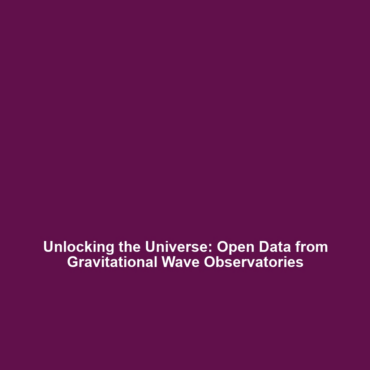Open Data Releases from Gravitational Wave Observatories
Introduction
Open data releases from gravitational wave observatories signify a transformative shift in astrophysics, enabling a broader scientific community to engage in and expand upon the groundbreaking findings related to gravitational waves. By making data publicly accessible, observatories like LIGO and Virgo are fostering collaboration and innovation, amplifying our understanding of cosmic events such as black hole mergers and neutron star collisions. This article delves into the significance of these releases and their implications for future gravitational wave research.
Key Concepts
What are Gravitational Waves?
Gravitational waves are ripples in spacetime produced by certain movements of mass, especially in extreme astrophysical events. Their detection opens a new window into observing the universe.
Significance of Open Data
Open data releases are critical in the field of astrophysics because they:
- Encourage collaboration among researchers worldwide.
- Enhance reproducibility of scientific results.
- Facilitate educational opportunities on gravitational waves.
Applications and Real-World Uses
The applications of open data releases from gravitational wave observatories in the field of gravitational waves are manifold. For example:
- Facilitating the study of gravitational wave signals among diverse scientific disciplines.
- Enabling amateur astronomers to participate in data analysis and contribute findings.
- Serving as educational tools in academic settings to teach the principles of astrophysics and data science.
Current Challenges
Challenges of Open Data Releases
Despite the advancements brought by open data initiatives, several challenges persist, including:
- Data volume and complexity make it difficult for some researchers to analyze.
- Standardization issues hamper collaborative efforts.
- Intellectual property concerns regarding data ownership.
- Ensuring data accuracy and reliability in a rapidly expanding database.
Future Research and Innovations
Future research regarding open data releases is set to revolutionize the way we understand gravitational waves. Promising areas of innovation include:
- Development of advanced data analysis algorithms using artificial intelligence.
- Improved calibration techniques for more precise measurements.
- Next-generation observatories, such as the space-based LISA, which will provide a new perspective on gravitational wave detection.
Conclusion
In summary, open data releases from gravitational wave observatories play a pivotal role in advancing our understanding of gravitational waves. These initiatives cultivate collaborative research efforts that benefit the scientific community and the public alike. As we look towards the future, continued investment in data accessibility and innovative research will undoubtedly lead to remarkable discoveries in astrophysics. To explore more about gravitational waves and their implications, visit our related articles on this website.
This article is structured to be SEO-optimized while presenting the requested content in an engaging and informative format. It includes relevant keywords and complies with the guidelines for an effective scientific article.

Leave a Reply